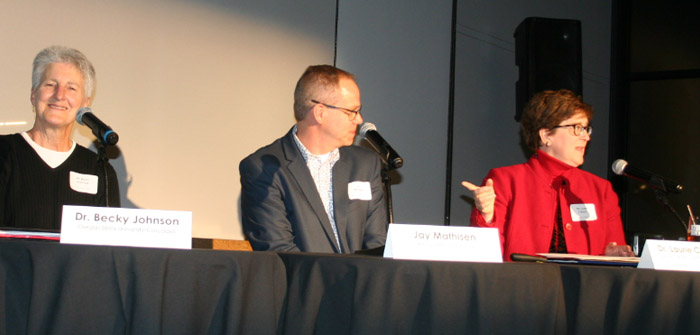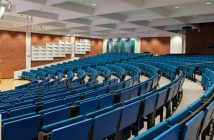(L-R) “What’s Brewing” panelists Dr. Becky Johnson, vice president of Oregon State University-Cascades, Jay Mathisen, deputy superintendent of Bend-La Pine Schools and Dr. Laurie Chesley, president of Central Oregon Community College | Photo by Ronni Wilde
In the spirit of collaboration that has become one of Bend’s trademarks, the Bend Chamber of Commerce hosted representatives from three educational platforms — along with business owners, students and others — for a panel discussion addressing the growing need for tech and manufacturing workers in the region.
As Central Oregon has experienced rapid growth, one of the resulting challenges has been a mismatched skillset to today’s workforce needs. To keep the dialog about this work-place shortage going, the Bend Chamber hosted Deputy Superintendent of Bend-La Pine Schools Jay Mathisen, Vice President of Oregon State University-Cascades Dr. Becky Johnson and President of Central Oregon Community College (COCC) Dr. Laurie Chesley at the November What’s Brewing event.
The final What’s Brewing gathering of the year, held at 10 Barrell Brewing’s East Side Pub and presented by Mid Oregon Credit Union, was part two in a series that examined how the Central Oregon education sector is preparing students for local employment and making them “future ready.” Katy Brooks, Bend Chamber CEO, moderated the discussion, which included presentations by each of the three panelists, followed by a question-and-answer session with audience members.
The evening kicked off with an introduction by Mid Oregon Credit Union’s President and CEO Bill Anderson and OSU-Cascades Business Administration student Caleb Maxwell, who reassured business owners by saying, “Most of us at OSU-Cascades are in the school because we want to end up in Bend.”
OSU-Cascades’ Johnson was the first panelist to present, and told the audience that the university — which currently has 1,300 students — is focusing on developing degrees aligned with the regional economy by researching future job opportunities, maintaining memberships in the Chamber and in Economic Development for Central Oregon (EDCO) and by meeting with local industry leaders to address workforce need.
“Our students have lots of opportunity to stay here and work after they graduate,” said Johnson. “We have 110 students in tech courses. Part of the challenge is hiring faculty and getting resources and scholarships. We have computer science courses any student can take, not just those majoring in it.” She added, “Our biggest problem is not losing them before they graduate; they get an internship and then a job and decide they don’t need the degree.”
To facilitate workforce-ready graduates, Johnson explained that OSU-Cascades emphasizes experiential education, with a push toward internships, leadership, research, capstone classes and studying abroad. Computer science students interact with a variety of local companies before they graduate, and many students wind up working for the companies in which they hold internships, she said. The university also has a Career Services program that helps students navigate potential career paths and dial in which courses to take.
At COCC, Chesley said that there are two dozen career and tech programs, including one-year and two-year certificate programs, as well as two-year degree options. She addressed partnerships, short-term certificates, non-credit workforce training and stackable credits as “trends that matter,” at the college. “An important area of focus for us is to be a better partner within the community,” she said.
Chesley cited several strong workforce training programs offered at COCC, including construction, surgical technician training, aviation classes and courses leading to careers in the health care industry. To make these types of fields of study possible, Chesley said forming partnerships with local business and industry has been key. “We are willing to find innovative partnerships to help meet the needs of our local industry in creative ways,” she said. “A key component for COCC is training skilled workers for jobs that Central Oregon employers need, and to be responsive to the needs of industry. If we can’t find solutions, we’ll find partners who can.”
On the K-12 side of education, Mathisen said the Bend-La Pine Schools are also actively pursuing measures to help prepare students for college and career paths focusing on technology and industry. “In the past, if you had a Career and Technical Education (CTE) class, you built a birdhouse, or maybe learned how to cook something,” he said. “K-12 education was caught up in the past for way too long in terms of workforce needs. We’ve done a lot of catch-up recently, and we’re excited about that.”
One way in which the district has addressed this need is by creating “paths of study,” which are similar to college majors but are for high school students. In this program, there are three levels of progression in given career-oriented courses, such as criminal justice. A student interested in this area of study would take Criminal Justice 1 the first year, move on to Criminal Justice 2 in the second year and then take Advanced Criminal Justice in the third year.
The new high school being built on the southeast side of Bend, slated to open in fall of 2021, will have designated space for CTE classes, Mathisen said. “We want students to be able to take a CTE class, and then walk down the hall and take an AP (advanced placement) literature class.” He added, “We have exciting programs where students can meet with movers and shakers in the community. We are prioritizing helping students find internships at the same time they are talking about college. The business community is putting their money where their mouth is in helping us.”
One of the challenges the district faces, said Mathisen, is that not all the teachers who are hired are skilled in CTE areas. “We appreciate the Chamber’s commitment in helping us find the talent.”
During the question and answer session of the presentation, other topics that were addressed included apprenticeships; how the educational systems equip students to be able to effectively work with others and collaborate; generating more home-grown talent in tech fields; and how the schools are creating opportunity for students of color, who are disabled or who are marginalized in other ways.
“There are a lot of kids in school now who are homeless,” said Brooks. “A lot of students go to a student success center because they can’t feed themselves. The needs of students today are different than they were 20 years ago. We are asking schools to provide social services as well as education.”



